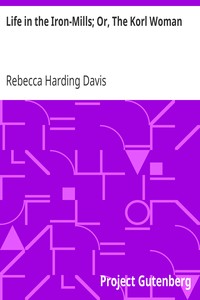Life in the Iron-Mills; Or, The Korl Woman by Rebecca Harding Davis
"Life in the Iron-Mills; Or, The Korl Woman" by Rebecca Harding Davis is a short story written in 1861. Set in nineteenth-century factory life, it follows Hugh Wolfe and his cousin Deborah, immigrant ironworkers struggling with poverty, disease, and brutal labor conditions. This pioneering work of American realism exposes the bleak existence of industrial workers, challenging readers to confront the human cost of progress. Through an unnamed narrator's window, Davis unveils a
forgotten story of suffering and survival in the mill-town darkness. (This is an automatically generated summary.)
Read or download for free
| How to read | Url | Size | |||
|---|---|---|---|---|---|
| Read now! | https://www.gutenberg.org/ebooks/876.html.images | 119 kB | |||
| EPUB3 (E-readers incl. Send-to-Kindle) | https://www.gutenberg.org/ebooks/876.epub3.images | 125 kB | |||
| EPUB (older E-readers) | https://www.gutenberg.org/ebooks/876.epub.images | 125 kB | |||
| EPUB (no images, older E-readers) | https://www.gutenberg.org/ebooks/876.epub.noimages | 104 kB | |||
| Kindle | https://www.gutenberg.org/ebooks/876.kf8.images | 258 kB | |||
| older Kindles | https://www.gutenberg.org/ebooks/876.kindle.images | 250 kB | |||
| Plain Text UTF-8 | https://www.gutenberg.org/ebooks/876.txt.utf-8 | 102 kB | |||
| Download HTML (zip) | https://www.gutenberg.org/cache/epub/876/pg876-h.zip | 123 kB | |||
| There may be more files related to this item. | |||||
Similar Books
About this eBook
| Author | Davis, Rebecca Harding, 1831-1910 |
|---|---|
| Title | Life in the Iron-Mills; Or, The Korl Woman |
| Note | First published in The Atlantic Monthly, April 1861. |
| Note | Wikipedia page about this book: en.wikipedia.org/wiki/Life_in_the_Iron_Mills |
| Credits | Produced by an Anonymous Volunteer and David Widger |
| Reading Level | Reading ease score: 82.3 (6th grade). Easy to read. |
| Language | English |
| LoC Class | PS: Language and Literatures: American and Canadian literature |
| Subject | Women iron and steel workers -- Fiction |
| Subject | Feminism -- Fiction |
| Category | Text |
| EBook-No. | 876 |
| Release Date | Apr 1, 1997 |
| Most Recently Updated | Jan 27, 2021 |
| Copyright Status | Public domain in the USA. |
| Downloads | 2033 downloads in the last 30 days. |
| Project Gutenberg eBooks are always free! | |

